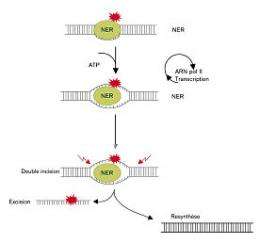DNA and its complexes

Throughout life, DNA repair mechanisms go to work during exposure (UV radiation, etc.) in order to protect the human genetic code. This role is assured by the NER complex.
A team of French researchers headed by Jean-Marc Egly, Inserm research director at the Institute of Genetics and Molecular and Cellular Biology (IGBMC, CNRS / Inserm / Université de Strasbourg) has shown that NER's role goes well beyond repairing DNA: it regulates transcription, the first stage for all processes necessary for life.
This research was published in the 9 April 2010 issue of Molecular Cell.
Repairing damaged DNA…
The human organism has developed a number of strategies to protect and maintain its genetic code. The harmful effect of physical and chemical mutagens causes lesions in the DNA and disturbs genetic coding. If efficient repair systems do not respond to the lesions, they will cause mutations leading to cancers and ageing. Jean-Marc Egly carried out research several years ago that led to the discovery (by identifying the TFIIH factor) of the relationship between the gene reading mechanism and the DNA repair mechanism named NER (nucleotide excision repair) that guarantees genetic stability (see illustration).
Due to this discovery, diseases involving alternation of DNA repair mechanisms will now be better understood. This is the case for the “children of the moon” who suffer from xeroderma pigmentosum, a rare genetic disease characterised by extreme sensitivity to sunlight and a very high risk of skin cancer. The disease has been linked to mutations in eleven of the genes involved in repair mechanisms. The mutations themselves are however insufficient to explain the neurological symptoms and developmental disorders found in more than a third of the persons with the disease.
The researchers thus formulated a hypothesis: the various factors implicated in DNA repair appear to have functions beyond the role already described.
…and regulating transcription
For the new study, researchers were interested in the operation of NER in conditions where DNA is not exposed to mutagens. In this case, data gathered by IGBMC's team reveals that various factors in the NER complex regulate RNA gene transcription. Each of the factors is involved in the mechanisms to modify the chromatin to prepare the starting point of RNA synthesis for transcription. Without these factors, transcription will be very limited.
Depending on the exact location of NER, repair and transcription functions will be activated. For Jean-Marc Egly, research director at Inserm, “This discovery explains the variety of symptoms observed in xeroderma pigmentosum. It also represents a big step forward in understanding “epigenetic” mechanisms which regulate genetic coding and prevent genes from proper coding in the right place at the right time.”
More information: Molecular Cell, April 2010
Provided by CNRS













